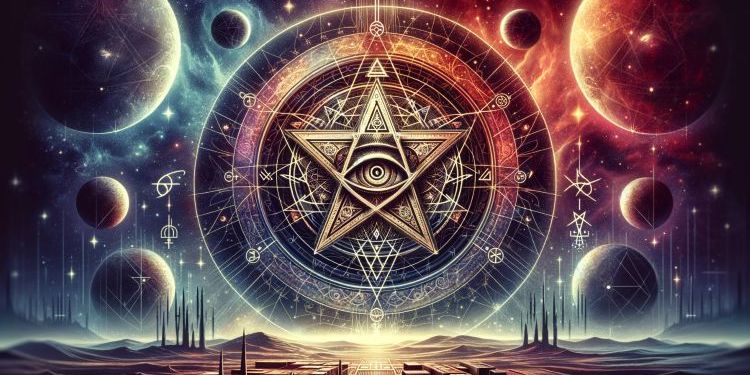Thelema stands at the crossroads of mysticism and ceremonial magic. Rooted in the belief of finding and following one’s true will or purpose in life, it merges ancient wisdom with modern thought, creating a rich tapestry of esoteric teachings and practices.
At the heart of this complex system are Thelema symbols, each imbued with deep mystical meanings and serving as key tools for spiritual insight and ritualistic practices.
Symbols in Thelema are not mere representations; they are gateways to understanding deeper truths about the universe and oneself. They serve as focal points in meditation, as talismans in magical workings, and as emblems representing various divine and metaphysical concepts.
This article aims to explore some of the most significant symbols in Thelema, namely the Unicursal Hexagram, the Rose Cross, the Star of Babalon, Eye of Horus and the Pentagram.
Each of these symbols carries its unique history, meaning, and application within the Thelemic tradition, offering insights into the heart of Thelemic thought and practice.
Thelema: An Introduction to the Esoteric Philosophy
- The Unicursal Hexagram: Thelema Symbol of Divine Harmony
- The Rose Cross: Thelema Symbol of Cosmic Union and Spiritual Attainment
- The Star of Babalon: Thelema Symbol of Liberation and Divine Femininity
- The Eye of Horus: Thelema Symbol of Protection and Enlightenment
- The Pentagram: Thelema Symbol of Elemental and Spiritual Balance
- Conclusion
The Unicursal Hexagram: Thelema Symbol of Divine Harmony
Description
The Unicursal Hexagram is one of the most recognizable and significant symbols within the Thelemic tradition. Though it has been used in various mystical traditions, its adoption and adaptation by Aleister Crowley for Thelema marked a significant moment in its evolution.
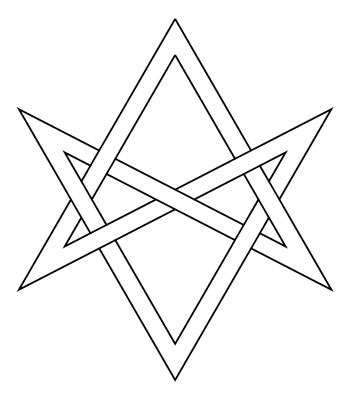
At first glance, the Unicursal Hexagram appears as a six-pointed star drawn in a single, continuous line.
Unlike the traditional hexagram or the Star of David, which is composed of two overlapping triangles, the Unicursal Hexagram’s design allows it to be drawn without lifting the pen from the paper, symbolizing a continuous and uninterrupted flow of energy.
Central to the Thelemic hexagram is a five-petaled flower, each petal aligning with one of the star’s points.
Symbolic Meaning
In Thelemic thought, the Unicursal Hexagram represents the intertwining of the macrocosm and microcosm, the universal and the personal.
The seamless line of the hexagram symbolizes the unity and balance of opposing forces, a core tenet of Thelema.
The central five-petaled flower, symbolizing the pentagram, brings in the elements and the human spirit, emphasizing the importance of the human will in achieving spiritual enlightenment and mastery over the material world.
Use in Rituals
The Unicursal Hexagram is a powerful tool in Thelemic rituals.
It is used to invoke and harmonize planetary and elemental energies, representing the magician’s control over both the celestial and terrestrial realms.
One notable Thelemic ritual that utilizes the Unicursal Hexagram is the “Lesser Ritual of the Hexagram.”
This ritual is designed to invoke or banish planetary energies and is typically performed after the “Lesser Ritual of the Pentagram,” which deals with elemental energies.
The use of the Unicursal Hexagram in this context is pivotal for directing and harmonizing celestial forces.
In addition to its protective qualities, the symbol serves as a focal point for meditation, helping practitioners align with the spiritual energies it represents.
The Rose Cross: Thelema Symbol of Cosmic Union and Spiritual Attainment
While the Rose Cross has its origins in older mystical traditions, particularly within Rosicrucianism and Christian mysticism, Thelema adopts and reinterprets this symbol.
Aleister Crowley integrated the Rose Cross into Thelemic practice, infusing it with new meanings and aligning it with Thelemic principles, such as the pursuit of one’s True Will and the blending of magical and mystical paths.
Thelemic Cosmological Associations
The Rose Cross in Thelema intricately connects with the cosmological figures of Nuit and Hadit.
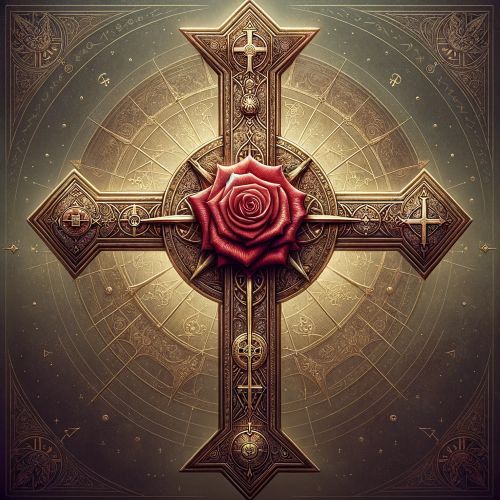
The rose is identified with Nuit, the goddess representing the infinite expanse of the universe and the night sky.
Conversely, the cross corresponds to Hadit, the atomic point of ultimate contraction and Nuit’s complement.
Their interplay symbolizes the dynamic cosmic dance of the vast and the minute, encapsulating the universe as a play of expansive and contracting forces.
Symbolic Interpretation
The conjunction of the rose (Nuit) and the cross (Hadit) in the Rose Cross emblem is a grand representation of the Great Work – the core aim of spiritual and magical practice in Thelema.
This union is a symbol of the merging of the macrocosm and microcosm, the reconciliation of opposites, and the path to spiritual enlightenment.
It signifies the alchemical marriage, the mystical union that transcends duality.
Crowley’s Elaboration of the Symbol
Aleister Crowley’s interpretation adds layers of esoteric meaning to the Rose Cross.
He equates the Tau (cross) and the circle (rose) with other mystical symbols like the Lingam-Yoni, Ankh, and architectural elements like spires and naves.
In each representation, the symbol retains its core meaning – the union of dualities leading to the creation of something transcendent.
Practical Application in Thelema
In practical Thelemic work, the Rose Cross serves as a tool for meditation and visualization, aiding in the alignment with these cosmic principles.
It is also used in ritual contexts, particularly in operations aimed at achieving the Great Work, symbolizing the practitioner’s journey towards spiritual awakening and unity with the cosmos.
The Star of Babalon: Thelema Symbol of Liberation and Divine Femininity
The Star of Babalon in Thelema is a profound emblem representing the liberated woman and the divine feminine.
This seven-pointed star, or heptagram, encapsulates the essence of Babalon, a central deity in Thelemic cosmology, embodying sexual freedom, strength, and transformation.
Introduction to Babalon
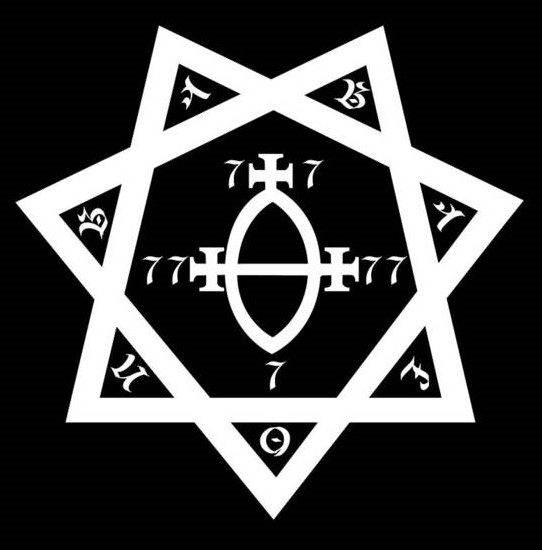
Babalon, central to Thelemic belief, is revered as the embodiment of the divine feminine, symbolizing both the nurturing and destructive aspects of this force.
Often referred to as the Scarlet Woman, she is a figure of liberation, sexual freedom, and the subversion of traditional roles and structures. In Thelemic cosmology,
Babalon is often juxtaposed with the Beast, and together they embody the union of opposites, a recurring theme in Thelemic philosophy.
Babalon: The Archetypal Feminine in Thelema
Symbolism and Meaning
In Thelemic belief, the Star of Babalon signifies the liberated woman’s role and presence in the universe. It reflects Babalon’s nature as both a nurturing and destructive force, illustrating the dual aspects of creation and annihilation.
Through this symbol, Babalon is celebrated as a figure of absolute freedom, transcending traditional roles and societal norms.
This symbol also echoes the themes of sexual liberation and the sacredness of sexuality, viewing it as a powerful force for spiritual growth and transformation.
Ritualistic Use
The Star of Babalon is utilized in various Thelemic rituals as a symbol to invoke Babalon’s energy.
It is particularly prominent in rituals that focus on sexual magic, empowerment, and the breaking of restrictive societal norms.
The symbol serves as a focus for meditation and contemplation, aiding practitioners in connecting with the divine feminine and embracing their own power and liberation.
The Eye of Horus: Thelema Symbol of Protection and Enlightenment
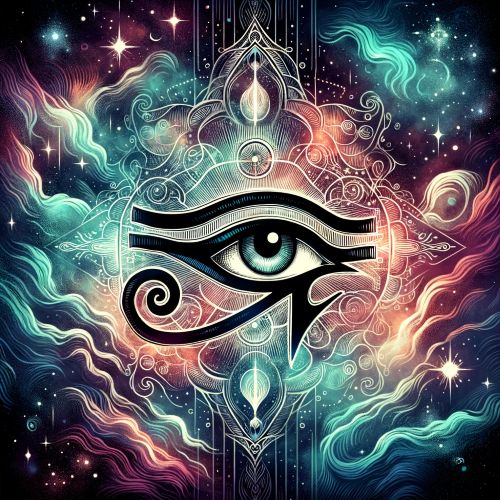
The Eye of Horus, also known as the Wadjet, is an ancient Egyptian symbol of protection, royal power, and good health. It is often depicted as a stylized eye and eyebrow.
This symbol has a mythological origin story involving the battle between Horus and Set, where Horus loses his eye, which is later restored. The Eye of Horus traditionally symbolizes healing, restoration, and protection.
Horus in Thelema Beliefs
In Egyptian mythology, Horus was the son of Osiris and Isis and is traditionally associated with the sky, the sun, and kingship.
In Thelema, Horus takes on a more complex and symbolic role.
Crowley’s Thelemic cosmology introduces the concept of the Aeon of Horus, a new era in human spiritual evolution. This concept posits that human history can be divided into Aeons, each overseen by a different divine figure.
The Aeon of Horus, which Crowley believed began in 1904, is characterized by the principles of individualism and self-realization.
It followed the Aeon of Osiris, which was dominated by the themes of death and resurrection, much like the mythology of Osiris himself.
The Eye of Horus in Thelemic Symbolism
Aleister Crowley, the principal figure in Thelema, adopted the Eye of Horus as a symbol of protection, enlightenment, and divine oversight. He saw it as a representation of the spiritual vision and awareness that is central to Thelemic teachings.
The incorporation of Horus and the Eye of Horus into Thelema reflects Aleister Crowley’s broader practice of synthesizing various religious and mythological symbols into his spiritual philosophy.
In Thelema, these ancient Egyptian elements are reinterpreted and given new layers of meaning, emphasizing themes of personal spiritual awakening, the quest for enlightenment, and the ushering in of a new era in human consciousness.
In practical Thelemic work, the Eye of Horus often features in meditation and visualization exercises. It is used to focus the mind on spiritual goals and to invoke divine protection and guidance.
The symbol may also appear in ritual contexts, serving as a reminder of the aspirant’s commitment to seeking higher knowledge and understanding.
The Pentagram: Thelema Symbol of Elemental and Spiritual Balance
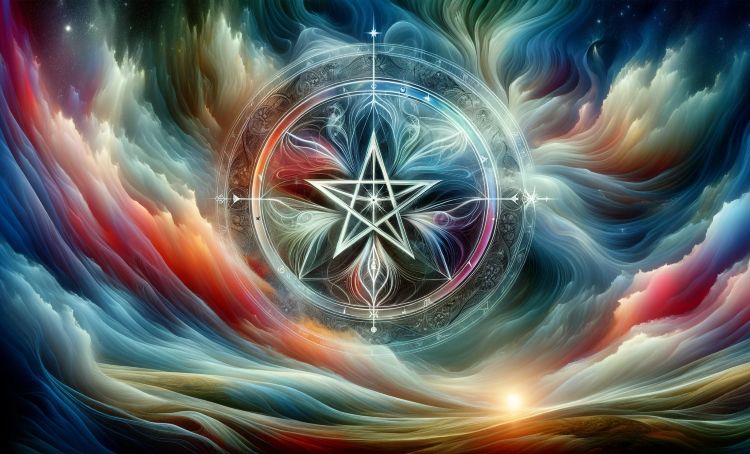
The Pentagram is a prominent and multifaceted symbol in Thelema. It represents the synthesis of elemental forces and the dominion of the spirit over the material world.
This symbol’s extensive use in Thelemic practice reflects its deep significance in the broader context of magical traditions.
Description
The Pentagram in Thelema is typically depicted as an upright five-pointed star, with each point representing one of the four classical elements (Earth, Air, Fire, Water), and the top point symbolizing Spirit.
This arrangement emphasizes the supremacy of the spiritual over the physical elements, aligning with the Thelemic principle of achieving mastery over the material realm through spiritual means.
Symbolic Meanings
In Thelemic thought, the Pentagram is a microcosmic symbol, representing the human being as a reflection of the universe.
It symbolizes the integration of the human will with the elemental forces of nature, encapsulating the core Thelemic tenet of finding and executing one’s True Will.
The Pentagram also serves as a symbol of protection, often used to guard against negative or chaotic forces.
Ritual Use: The Lesser Ritual of the Pentagram
The Pentagram’s most significant application in Thelemic magic is undoubtedly the Lesser Ritual of the Pentagram (LBRP).
This ritual, though seemingly straightforward, is a foundational practice in Aleister Crowley’s system of Thelema and holds profound significance in the daily spiritual practices of Thelemites.
- Invocation or Banishment of Elements: The primary function of this ritual is to invoke or banish specific elemental energies within a defined space. It aligns the practitioner with the microcosmic forces (the personal or human level) and the macrocosm (the universal or cosmic level), creating a harmonious balance between the two.
- Foundation of the Great Work: It’s daily practice is considered foundational to the Great Work in Thelema. By regularly performing this ritual, the practitioner works towards the ultimate goal of uniting the material and spiritual worlds, a central objective in Thelemic philosophy.
- Spiritual Attunement and Transformation: Through the LBRP, practitioners are not just conducting a ritual; they are actively engaging in a process of transformation. It serves as a tool for aligning one’s personal will with the universal will, facilitating spiritual growth and development.
- A Core Practice in Thelema: The Lesser Ritual of the Pentagram is considered by many to be the single most important ritual in Crowley’s Thelemic system. Its regular practice is essential for those seeking to delve deeply into Thelemic magic and spirituality, offering a structured approach to achieving higher states of consciousness and spiritual mastery.
Conclusion
As we conclude our exploration of the symbols in Thelema, it becomes evident that each emblem – the Unicursal Hexagram, the Rose Cross, the Star of Babalon, and the Pentagram – is not merely a visual artifact but a portal to deep spiritual insights and practices.
Thelema symbols offer a language through which the mysteries of the universe can be communicated and understood, and a means by which the individual can align with the larger cosmic order.
They encapsulate the essence of Thelema: the quest for knowledge, the pursuit of personal transformation, and the ultimate goal of unifying the spiritual and material worlds.
